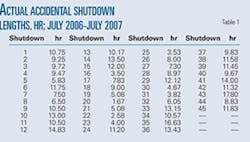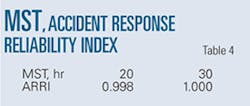Waxy crude shutdown method yields savings
A new method for determining the maximum shutdown time of a waxy crude oil pipeline is not only more accurate and flexible, but can also yield substantial savings in heating costs compared to the subjective methods employed before a pipeline enters service.
Pipeline operators often heat waxy crude lines to ensure safe and economic transport.1 Shutdowns may occur regularly for operational reasons and occasionally for such emergencies as pipe ruptures.2 Shutdowns lower the temperature of the oil, increasing its viscosity and strengthening its thixotropic tendencies,3 the combination of which requires a large start-up pressure. Start-up pressure exceeding the capacity of the pipe could lead to pipe failure, resulting in potentially large economic losses.4
Increasing heating temperature before a planned shutdown can help ensure a successful restart. An accidental shutdown, however, requires that restart occur before a predetermined maximum shutdown time has elapsed. This time can be increased by heating the line after the shutdown has occurred. The operator must, however, return the pipeline to service before reaching the MST, even if it means incurring such associated risks as soil contamination.
For large-throughput hot oil pipelines, however, reducing the heating temperature even slightly may save a great amount of fuel,4 creating a potential conflict with the desire to maximize MST. How to save fuel while ensuring reliable and safe operations therefore becomes an important question.
Background
China has subjectively established different MSTs for different seasons for different hot waxy crude pipelines,5 6 with little attention given to the MST’s rationality. Subjective determination is necessary and practical for a new pipeline. Continued use of the same MST for many years, however, exposes the pipeline to both potential inefficiencies and potential safety concerns.
New developments in emergency tools and technology have also greatly reduced the time required to deal with an accident, further increasing the need to reevaluate MST for hot waxy crude pipelines.
This article accounts for the uncertain duration of an accidental shutdown and proposes an accident response reliability index to assess how individual accidents are handled. Simple methods use this index to determine and evaluate the MST of hot waxy oil pipelines in operation for a few years. A case study then illustrates these methods and the results are analyzed. Results show that the proposed methods can both save fuel and ensure effective response to accidents during pipeline operation.
Accident index
The longer the time available to deal with an accident, the more likely it is to be addressed successfully, with the reverse also holding true. The relationship between the required time and the available time to deal with accidents can therefore characterize the success with which pipeline accidents are addressed, yielding an accident response reliability index.
Equation 1 defines and calculates the index, R, which in turn represents the probability of successfully addressing a pipeline accident. A large R means a high probability that the accident will be effectively addressed.
Determining MST
Many factors influence the time required to deal with an accident: its location, type, etc.7 Most of these factors are uncertain and stochastic. It is very complex, perhaps even impossible, quantitatively to investigate the relationship between the time required to deal with an accident and its factors. But pipelines with many years of operational history will instead have actual accidental shutdown data recorded.
The actual shutdown times can represent the time required time to deal with accidents, while the MST, as the longest possible shutdown time, can represent the available time. Substituting the MST and actual accidental shutdown times into Equation 1 yields Equation 2; calculating the accident response reliability index for a given MST.
Equation 2 can also use the real shutdown times and distribution law to determine MST for a given pipeline.
The following steps, therefore, determine a pipeline’s MST:
- Gather the data. Collect shutdown times, accident type, cause, position, etc.
- Determine the distribution of actual shutdown times. Analyze the data and remove invalid points. Integrate the valid data and use hypotheses testing to study the distribution of the actual shutdown times.
- Obtain objective reliability from the pipeline operator.
- Determine MST. Simulate the distribution of the actual shutdown times and iteration calculation according to the operator’s objective reliability.
MST evaluation
The length of MST affects both the transportation cost and the efficiency with which accidents can be addressed.
The following steps evaluate the rationality of a given MST:
- Gathering actual accidental shutdown data and the safety requirements of the pipeline. This requires gathering as much accidental shutdown data as possible and determining their distribution.
- Calculating the accident response reliability index of the pipeline using MST. Integrate the gathered data and determine the distribution of the accidental shutdown time using hypotheses testing. Then use Equation 2 to calculate ARRI.
- Comparing the calculated ARRI and an objective one. If the former is much smaller than the later, the MST is unreasonable in terms of safety. If the calculated ARRI is much larger than the objective value, however, the MST is similarly unreasonable due to unnecessary heating.
An ARRI a bit smaller than the safety requirement yields a reasonable MST. A calculated ARRI a bit larger than the safety requirement, however, requires further calculation before making judgment.
Case study
A pipeline in northeast China, 720-mm OD and 459 km long, provides an example, using one input station, one terminal, and five intermediate heating-pumping stations. The pipeline has operated for 34 years and has a safety target of 0.999.
Given that accident shutdown times from many years ago would no longer represent actual shutdown times, Table 1 only considers accidental shutdowns that occurred over the past 6 years. The longest shutdown measures 17.8 hr, and the shortest 1.67 hr.
The W test method often judges if probability distribution of studied samples meets the norm. The W method requires between 3 and 50 samples. The 45 samples studied here satisfy this requirement.
The following sequence can determine the distribution law:8
- Sort the samples in ascending sequence: X(1) X(2)......X(n).
- Calculate W (Equation 3). Table 2 calculates and lists the value of X(n+l-k)-X(k) and ak(W).
- If W< Wα, reject the null hypothesis H0; the actual shutdown time doesn’t meet the normal distribution. Otherwise, accept the null hypothesis H0.
Equation 4 shows the values calculated by Table 2.
Values of α=0.05 and n=45, yield Wα=0.945. For W> Wα, accept the null hypothesis H0; the actual accidental shutdown time meets the normal distribution.
Equation 5 can calculate the ARRI for the studied pipeline with a given shutdown time.
Iterative calculation yielded a 21-hr shutdown time based on the safety requirement of 0.999 and the accidental shutdown time records.
The safety requirements of a pipeline operator also affect the length of MST determined by the proposed method. Different MSTs for the pipeline studied in this article satisfied different safety requirement levels of the operator (Table 3). A safety requirement of 0.9999 needed a 23-hr MST, while only 18 hr were needed to meet a safety requirement of 0.99.
MST rationality
Shutdowns of 20 hr MST occurred on the pipeline in January, February, March, April, May, November, and December; 30-hr MST shutdowns in June, July, August, September, and October.6
Table 4 lists the ARRI for the MSTs.
An ARRI of 0.998 existed for the 20-hr MST, a deviation of only 0.001 from the objective value of 0.999. The 20-hr MST therefore satisfied basic safety requirements and was reasonable in terms of fuel economy. The fact that no accidents had failed to be properly resolved due to a lack of time in the past 33 years further proved that a 20-hr MST was sufficient.
An ARRI of 1.000 existed for the 30-hr MST. Although it had the same deviation of 0.001, a 21-hr MST was proven by further calculations to be enough to realize the safety requirement of 0.999, making a 30-hr MST unnecessary.
Table 5 lists the studied pipeline’s heating consumptions for both a 21 and 30-hr MST. The 5 30-hr MST months represented two groups, divided according to environmental conditions. Group A includes June and October. Group B includes July, August, and September. The pressure at restart determined safe pumping temperature, replacing the more conventional pour-point temperature method of reaching this determination.9 10
Reducing MST to 21 hr from 30 hr can save 341.8 GJ/day of heating consumption in June and October at a throughput of 19,200 tons/day (Table 5). Heat supplied by oil with a heating value of 44.1 × 106 J/kg would therefore save 7.75 tons/day of oil in June and October, for a total saving during the 2 months of 472 tons. A similar reduction of MST for July, August, and September would save 200.3 GJ/day; or 4.54 tons/day of oil, for a total savings of about 417 tons of oil.
Reducing MST to 21 hr from 30 hr would save a total of 889 tons of oil over the 5 months studied, demonstrating that the 30-hr MST in place was uneconomical.
Acknowledgments
The authors thank Wei Li, who gathered part of the actual shutdown time data used in this work.
References
- Xiaoheng Yang and Guozhong Zhang, Design and management for oil transportation pipelines, Beijing: Petroleum University Press, 1996.
- Chang, C., Nguyen, Q.D., and Ronningsen, H.P., “Isothermal start-up of pipeline transporting waxy crude oil,” Journal of Non-Newtonian Fluid Mechanics, No. 87, pp. 127-154, 1999.
- Dafan Yan and Zheming Luo, “Rheological properties of Daqing crude oil and their application in pipeline transportation,” SPE Production Engineering, No. 11, pp. 267-276, 1987.
- Jinjun Zhang, Jianlin Ding, et al., “Determination of safe pumping temperature for waxy crude pipelines,” International Pipeline Conference, Calgary, Sept. 25-29, 2006.
- Q/SHGD 0048-2001, Safe operation code for waxy crude oil pipelines, 2001.
- Dispatcher manual for northeast pipelines.
- Guozhong Zhang and Zhixiang Ma, “Determination of safe and economic transportation temperature in hot oil pipelines,” Journal Acta Petrolei Sinica, Vol. 25, No. 1, pp. 106-109, 2004.
- Xiang Li, Yongle Li, and Qingjun Hu, Applied Mathematical Statistics, Beijing: National University of Defense Technology Press, 2001.
- National Development and Reform Commission, The operation and regulation of crude oil pipelines, November 2004.
- Kang Xu, “Study on the flow safety evaluation of buried waxy crude pipelines and its application,” PhD dissertation, China University of Petroleum (Beijing), 2005.
The authors
Huajun Fan ([email protected]) is a PhD candidate at the China University of Petroleum at Beijing. He holds a BS (1998) in mechanical design and manufacturing engineering and has 4 years’ working experience in the petroleum industry and 5 years’ experience in the research of crude oil pipeline transportation.
JinJun Zhang ([email protected]) is a professor and head of the department of petroleum storage and transportation at China University of Petroleum at Beijing. He holds BS (1982), MS (1987), and PhD (1998) degrees in petroleum storage and transportation engineering from the CUPB and has 25 years’ experience in teaching and research of crude oil theory and pipeline transportation.
Jinping Huang ([email protected]) is supervisor of dispatchers at PetroChina Pipeline’s Shenyang dispatch center. She holds a BS (1987) in petroleum storage and transportation and has worked at PetroChina Pipeline Co. as a senior engineer since 1991. Huang has worked in pipeline operation technologies and management for 20 years.









